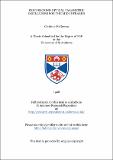Femtosecond optical parametric oscillators for the mid-infrared
Abstract
The research presented in this thesis is concerned with the generation and characterisation of femtosecond pulses in the near and mid-infrared spectral regions. The three optical parametric oscillators which were constructed were synchronously- pumped by a self-modelocked femtosecond Ti:sapphire laser. Noncollinear critical birefringent phasematching was used in an oscillator based on KTiOAsO4, which was tunable from 1.03 to 1.2 mum and 2.51 to 4.1 mum by varying the crystal angle. The mid-infrared pulses were sub-100 fs, and essentially free from frequency chirp. With appropriate dispersion compensation the near-infrared signal pulses were temporally compressed to 69 fs. Theoretical models of noncollinear phasematching were derived and the results agreed closely with experiment. A novel optical parametric oscillator design based on a semi-monolithic noncritically phasematched RbTiOAsO4 crystal was implemented. This unique cavity configuration allowed independent focussing of the pump and signal beams within the crystal. It facilitated a reduction in cavity length to bring the signal pulse repetition rate into synchronism with the second (172 MHz) and fourth (344 MHz) harmonics of the pump pulse repetition frequency. Extraction efficiencies as high as 55% were observed. Quasi-phasematched femtosecond optical parametric oscillation was demonstrated in periodically poled lithium niobate. This device offered extensive tunability, covering 0.975 to 1.54 mum in the signal branch and 1.67 to 4.55 mum in the idler branch, from a combination of grating, pump wavelength and cavity length tuning. A theoretical model indicated that a very broad gain bandwidth allowed the wide tuning range. An attractively low oscillation threshold of 45 mW was recorded, and a visible output of 70 mW at 540 nm was observed, caused by simultaneously phasematched frequency-doubling of the signal output. The pulses from the Ti:sapphire laser and from the optical parametric oscillators were characterised by autocorrelation and frequency-resolved optical gating techniques. A highly advantageous autocorrelator arrangement based on quadratic nonlinearity in light-emitting diodes and photodiodes was demonstrated, and a novel second harmonic generation frequency-resolved optical gating system allowed real-time monitoring of pulsed outputs and complete characterisation of the intensity and phase of pulses.
Type
Thesis, PhD Doctor of Philosophy
Collections
Items in the St Andrews Research Repository are protected by copyright, with all rights reserved, unless otherwise indicated.

